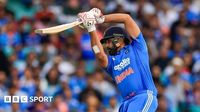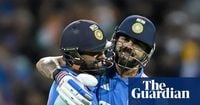The Sydney Cricket Ground was awash in a sea of blue and tricolor flags as India’s veteran duo, Rohit Sharma and Virat Kohli, delivered a masterclass to hand their side a resounding nine-wicket victory over Australia in the third and final ODI on October 25, 2025. Though the series had already tipped in Australia’s favor with wins in Perth and Adelaide, India’s performance in Sydney was a showcase of resilience, pride, and record-breaking brilliance.
Australia entered the match with the series already secured, having edged out India in two tightly contested games. In the first ODI at Perth, skipper Mitch Marsh led the hosts to a seven-wicket win with an unbeaten 46, while in Adelaide, emerging stars Cooper Connolly, Matt Short, and Mitch Owen guided Australia to a nail-biting two-wicket victory, clinching the series 2-0. But with the pride of avoiding a whitewash at stake, India came out swinging in Sydney.
Opting to bat first at a venue where batting first had been a winning formula in the last nine ODIs, Australia’s top order made promising starts but failed to convert them into big scores. Matt Renshaw, making the most of his opportunity in this series, top-scored with 56 off 58 balls—his maiden ODI half-century. The rest of the lineup, including Short (30), Head (28), and Marsh (23), found themselves undone by India’s disciplined attack. Harshit Rana, the young Indian seamer, was the pick of the bowlers, claiming a career-best 4-39 and mopping up the Australian tail with two wickets in three balls to finish the innings at 236 all out in 46.4 overs.
India’s response was clinical and emphatic. Captain Shubman Gill opened alongside Rohit Sharma, putting on a brisk 69-run stand before Gill was caught behind off Josh Hazlewood for 24. That brought Virat Kohli to the crease—a man under pressure after registering consecutive ducks for the first time in his ODI career during the earlier matches. The crowd, which had transformed the SCG into a virtual home ground for the visitors, erupted as Kohli strode out to join Rohit.
What followed was vintage "Ro-Ko" magic. The two modern greats put on an unbroken 168-run partnership, their 19th ODI century stand together. Rohit Sharma, at 38 years and 178 days, became the second-oldest Indian to score a century in men’s ODIs, reaching his 33rd ton in the format with a characteristic blend of aggression and composure. He smashed 13 fours and three sixes in his unbeaten 121 off 125 balls, marking his ninth century against Australia and solidifying his place as one of the game’s premier white-ball openers.
Kohli, meanwhile, put his early-series struggles firmly behind him, compiling a fluent 74 not out off 81 deliveries. With this knock, he not only shared in the match-winning partnership but also achieved several personal milestones. Kohli surpassed Kumar Sangakkara to become the second-highest run-scorer in ODI history with 14,255 runs, and he broke Sachin Tendulkar’s record for the most runs in limited-overs internationals, now boasting 18,443 career runs. Kohli also equaled Tendulkar for the most 50-plus scores in run chases in men’s ODIs and became the first batter to score over 6,000 runs in successful run chases.
Rohit’s century was sealed with a deft drive, while Kohli brought up his 75th ODI half-century to a thunderous ovation. The chemistry between the two was palpable, as Kohli later reflected, “When we bat together … even back in the day, we used to think, if we have a big partnership, the kind of strokes we can play, we can really take the game away from the opposition. The opposition also knew that if these guys are in for 20 overs together, any total is chaseable.”
Australia’s bowlers toiled in vain as the Indian pair executed mature shot selection and rotated the strike with ease. Rohit should have been caught on 108, but a misjudgment from Hazlewood gave him a reprieve, and he made the most of it, carrying his bat through the chase. Kohli fittingly hit the winning runs, gliding a short ball to the third-man boundary, sealing India’s only win of the series in style with 11.3 overs to spare.
Post-match, Rohit Sharma was reflective about his time in Australia, hinting that this might be his last tour Down Under in Indian colors. “I’ve always loved coming here … and a nice way to finish getting that knock and getting that win as well. I don’t know if we’ll be coming back to Australia, but it was fun all these years that we played here. A lot of good memories, bad memories. But all in all, I’ll take the cricket that I played here.”
The Sydney crowd, packed with Indian supporters, gave both men a hero’s sendoff, recognizing not just the win but the significance of their partnership and the possibility that this could be the final time the two legends share an Australian stage. Kohli echoed the sentiment, saying, “We want to say thank you. We’ve loved coming to this country and playing in front of such big crowds. And we’ve played some of our best cricket here as well.”
For Australia, the loss was a minor blemish on an otherwise successful series. Their attention now shifts to the upcoming five-match T20 series against India, starting October 29 in Canberra, before turning to the Ashes against England. Spinner Nathan Lyon provided a hopeful update on captain Pat Cummins, who missed the ODI series due to a back injury, suggesting he could be fit for the second Ashes Test in December. “He’s doing everything that he possibly can. That’s one where you’re really proud of him as a mate but also as a team-mate and your captain, he’s really leading the way by setting the example,” Lyon told ABC Sport.
As the ODI series concludes, Australia can celebrate the emergence of new talents like Connolly, Short, and Owen, while India can savor a memorable win powered by two of the greatest to ever don the blue jersey. With the T20s and Ashes looming, both teams will look to carry forward the lessons and momentum from a series that had everything: drama, records, and a fitting farewell—if it is to be—for two icons of the game.

